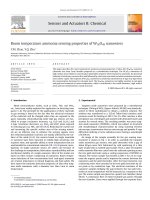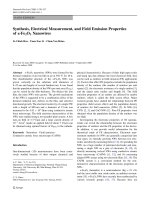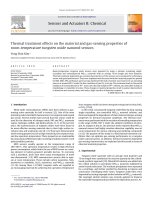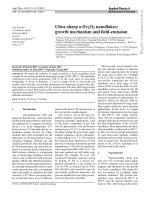- Trang chủ >>
- Khoa Học Tự Nhiên >>
- Vật lý
synthesis, electrical measurement, and field emission properties of a-fe2o3 nanowires
Bạn đang xem bản rút gọn của tài liệu. Xem và tải ngay bản đầy đủ của tài liệu tại đây (799.74 KB, 8 trang )
NANO EXPRESS
Synthesis, Electrical Measurement, and Field Emission Properties
of a-Fe
2
O
3
Nanowires
Li-Chieh Hsu Æ Yuan-Yao Li Æ Chun-Yen Hsiao
Received: 26 June 2008 / Accepted: 18 August 2008 / Published online: 9 September 2008
Ó to the authors 2008
Abstract a-Fe
2
O
3
nanowires (NWs) were formed by the
thermal oxidation of an iron film in air at 350 °C for 10 h.
The rhombohedral structure of the a-Fe
2
O
3
NWs was
grown vertically on the substrate with diameters of
8–25 nm and lengths of several hundred nm. It was found
that the population density of the NWs per unit area (D
NWs
)
can be varied by the film thickness. The thicker the iron
film, the more NWs were grown. The growth mechanism
of the NWs is suggested to be a combination effect of the
thermal oxidation rate, defects on the film, and selective
directional growth. The electrical resistivity of a single NW
with a length of 800 nm and a diameter of 15 nm was
measured to be 4.42 9 10
3
Xcm using conductive atomic
force microscopy. The field emission characteristics of the
NWs were studied using a two-parallel-plate system. A low
turn–on field of 3.3 V/lm and a large current density of
10
-3
A/cm
2
(under an applied field of about 7 V/lm) can
be obtained using optimal factors of D
NWs
in the cathode.
Keywords Nanowires Á Field emission Á
Conductive atomic force microscopy (CAFM)
Introduction
One-dimensional (1D) nanostructures have been exten-
sively studied because of their unique chemical and
physical characteristics. Because of their high aspect ratio
and sharp tips that enhance the local electrical field, they
can be used as emitters in field emission (FE) applications
[1]. Factors that affect FE properties include the population
density of the emitters (the number of emitters per unit
square) [2], the electronic resistance of a single emitter [3],
and the aspect ratio (radius and length) [4]. The field
emission properties of an emitter are affected by nearby
emitters, which is called the field screen effect. Many
research groups have studied the relationship between FE
properties (field screen effect) and the population density
of emitters for ZnO nanowires (NWs) [5], Si NWs [6],
CNTs [2, 3], and CuO NWs [1]. Poor FE properties were
obtained when the population density of the emitters was
too high.
Investigating the electronic properties of 1D nanoma-
terials can reveal the relationship between the electronic
properties of emitters and the FE properties of the device.
In addition, it can provide useful information for the
theoretical study of FE characteristics. Electronic mea-
surement methods for NWs are generally categorized into
four types: (1) laterally growing NWs between two elec-
trodes and directly measuring them [7, 8], (2) spreading the
NWs on a large number of patterned electrodes and mea-
suring a single NW on a pair of electrodes [9, 10], (3)
directly measuring vertical NWs using conductive atomic
force microscopy (CAFM) [11, 12], and (4) measuring
aligned NWs arrays using two electrode films [13, 14]. The
CAFM system is a convenient method for the non-
destructive characterization of the electronic properties of
NWs.
a-Fe
2
O
3
(hematite) is a semiconductor (Eg = 2.1 eV)
and the most stable iron oxide under an ambient environ-
ment [15]. a-Fe
2
O
3
NWs have recently been synthesized by
various research groups [16, 17]. Because they are
L C. Hsu Á Y Y. Li (&)
Department of Chemical Engineering, National Chung Cheng
University, 168 University Rd, Min-Hsiung, Chia-Yi 621,
Taiwan, R.O.C
e-mail:
C Y. Hsiao
TECO Nanotech Co. Ltd, Taoyuan 328, Taiwan, R.O.C
123
Nanoscale Res Lett (2008) 3:330–337
DOI 10.1007/s11671-008-9161-1
thermally stable, resistant to oxidation, and have a high
aspect ratio, a-Fe
2
O
3
NWs are a candidate emitters for FE
applications. It has been reported that an electrical field of
7–8 V/lm is required to obtain a 10
-5
A/cm
2
emission
current using densely packed a-Fe
2
O
3
NWs as emitters
[16]. However, there have been no detailed studies on FE
properties related to the population density of a-Fe
2
O
3
NWs (D
NWs
) and their resistance (R
NW
).
In this study, we report a simple method that can be used
to control the population density of a-Fe
2
O
3
NWs (D
NWs
)
by varying the film thickness of iron. The FE properties of
a-Fe
2
O
3
NWs with various population densities and resis-
tances (R
NW
) were studied. It was found that the best FE
properties can be obtained by using the optimal D
NWs
in
the cathode.
Experimental Details
a–Fe
2
O
3
NWs were grown using an iron film thermally
oxidized at 350 °C for 10 h. Iron films with thicknesses of
30 nm, 50 nm, 100 nm, and 150 nm were coated on
indium tin oxide (ITO) glass by direct current (DC) sput-
tering. The iron-coated substrates were heated at 350 °C
for 10 h in an oven in the air atmosphere. The morphology
and crystalline structure of the as-synthesized NWs were
characterized by field emission scanning electron micros-
copy (FE-SEM, HITACH S-4800) and high-resolution
transmission electron microscopy (HR-TEM, JEOL JSM
3010), respectively. The current–voltage (I–V) character-
istics of the as-grown NWs were obtained using the CAFM
(SEIKO SPA-400) system. A highly conductive polygon
shaped tip with a height of 10 lm and a radius of 50 nm
(the top of the tip) was used as an electronic probe while
ITO was used as an electrode. The applied voltages were
-10 V to ?10 V. FE properties were measured in a vac-
uum chamber at 6 9 10
-6
torr. The sweep voltage was
0–1100 V and the emission current was measured using
Keithley 2410.
Results and Discussion
Figure 1a and b shows the top view and cross-section view
of the Fe-coated (50 nm) ITO glass after thermal oxidation
at 350 °C for 10 h, respectively. As can be seen in Fig. 1a,
the NWs formed randomly on the film. Figure 1b shows
that the NWs were grown vertically on the film with
diameters of 8–25 nm and lengths of several hundred nm.
Fe film was oxidized during the process and became
a-Fe
2
O
3
film with a thickness of 100 nm.
Figure 2 shows the TEM images of an a-Fe
2
O
3
NW
which was grown on the iron film with a thickness of
50 nm. As can be seen in Fig. 2a, the length and diameter
of the as-produced a-Fe
2
O
3
NWs were approximately
240 nm and 25 nm, respectively. Figure 2b shows the
high-resolution TEM image and its corresponding selective
area electron diffraction (SAED) pattern (inset). It was
found that the NW is a single crystalline a-Fe
2
O
3
NW with
the [110] growth direction. The interplanar spacing of
0.251 nm agrees well with the fringe spacing of a-Fe
2
O
3
.
The SAED pattern reveals that the crystal structure of the
a-Fe
2
O
3
NW is rhombohedral.
The length, diameter, and population density of the
a-Fe
2
O
3
NWs were studied for various Fe film thicknesses.
Samples A, B, C, and D represent the materials after the
thermal oxidation of the 30 nm, 50 nm, 100 nm, and
150 nm-thick iron films, respectively. Figure 3a–d shows
the top views of sample A (30 nm), sample B (50 nm),
sample C (100 nm), and sample D (150 nm), respectively.
As can be seen, the number of a-Fe
2
O
3
NWs increased
with an increase of the film thickness. D
NWs
was calculated
from the SEM image as 1.6 9 10
8
NWs/cm
2
for sample A,
7.8 9 10
8
NWs/cm
2
for sample B, 13.2 9 10
8
NWs/cm
2
Fig. 1 FE-SEM images of (a) the top view and (b) cross-section view
of NWs synthesized on Fe-coated (50 nm) ITO glass at 350 °C for
10 h
Nanoscale Res Lett (2008) 3:330–337 331
123
for sample C, and 18.3 9 10
8
NWs/cm
2
for sample D.
Table 1 summarizes the population densities of the sam-
ples. Figure 3e shows a plot of NW density (D
NWs
) versus
iron film thickness. The error in the D
NWs
measurements is
about 5%.
The growth mechanism of the a-Fe
2
O
3
NWs via thermal
oxidation was discussed by Takagi [18] and Fu et al. [19].
They proposed that the growth mechanism of the a-Fe
2
O
3
NWs was neither vapor–liquid–solid (VLS) nor vapor–
solid (VS). A tip growth mechanism was suggested, in
which the NWs are grown by the diffusion of oxygen
atoms on the surface defects of the iron film. During the
thermal process, the oxygen molecules diffuse into the iron
film between the iron atoms and form Fe–O bonds. The
process involves a volume expansion in all three dimen-
sions to accommodate the oxygen atoms. However,
because the iron film prevents expansion in the two lateral
directions, the volume of oxides expands upward only. A
thin oxide film is therefore formed on the substrate. While
a layer of the oxide forms, defects are created in the oxide
film. This might be caused by a rapid thermal oxidation
rate on the surface of the film during the temperature
ramping period. The defects can be seen as crackings on
the surface of the film (Fig. 1a). As the oxidation time
increases, in regions with a higher degree of defects, the
oxygen molecules move faster, diffuse across the existing
oxide layer, and react with iron to form iron oxide. There
was an oxidation rate difference (growth rate of a-Fe
2
O
3
NWs) between the high degree and low degree defect
regions. In addition, the preferred growth orientation of
a-Fe
2
O
3
NWs was the [110] direction (Fig. 2b), which
suggests that the fastest growth rate was along the [110]
direction. Therefore, the oxidation rate difference and the
selective directional growth are probable reasons for the
formation of a-Fe
2
O
3
NWs. A schematic graph of the
formation of a-Fe
2
O
3
NWs is shown in Fig. 4. Samples I
and II represent the thin and thick iron films, respectively.
After oxidation for a period of time (stage A), the thin iron
film (sample I) was completely oxidized to become
a-Fe
2
O
3
NWs and a-Fe
2
O
3
film. In contrast, the thick iron
film was partially oxidized so that a-Fe
2
O
3
NWs, a-Fe
2
O
3
film, and Fe film were present in stage I. At this stage, for
both samples I and II, short NWs (\100 nm) and long NWs
([500 nm) grew from the low and high degree defect
regions of the film, respectively. As the oxidation time
increased (stage B), the length and D
NWs
of sample I did
not change because the oxidation terminated at stage A.
For sample II, the oxidation continued; NWs were con-
tinuously grown, becoming longer and more dense. Takagi
[18] observed that the population density and the length of
NWs were dependent of the oxidation time. Our results
show good agreement with Takagi’s report. The population
density of NWs can be increased by increasing the thick-
ness of the iron film.
CAFM was employed to measure the electronic property
of a single a-Fe
2
O
3
NW and a-Fe
2
O
3
film. Figure 5a shows
the schematic drawing of the CAFM measurement. NWs
were embedded in photoresist (PR) and only the tips of the
NWs (sample B) were exposed. The CAFM tip made
contact with the exposed tips of the NWs so that their
electronic properties could be measured. Using PR pre-
vented the bending of the NWs while the CAFM tip
approached them. The applied voltage was swept from
-10 V to ?10 V to obtain the I–V characteristics for a
single NW. The equivalent circuit diagram for the mea-
surement of an a-Fe
2
O
3
NW is shown in Fig. 5b. R
contact
is
the contact resistance between the CAFM tip and the NW.
R
NW
and R
film
are the resistances of the NW and the film,
respectively. The overall resistance (R
overall
) is the sum of
R
contact
, R
NW
, and R
film
. It can be expressed as:
R
overall
¼ R
contact
þ R
NW
þ R
film
: ð1Þ
Figure 5c shows the top view and side view (inset) of a
sample. As can be seen, a single NW with a diameter of
15 nm and a length of 800 nm was embedded in the PR.
Fig. 2 (a) TEM image of an a-Fe
2
O
3
NW, (b) HR-TEM image of the
a-Fe
2
O
3
nanowire, and the SAED pattern of the a-Fe
2
O
3
NW (inset)
332 Nanoscale Res Lett (2008) 3:330–337
123
Only the tip of the NW was exposed on the PR surface. The
figure also shows that the NWs were not bent or damaged
after the spin coating process of the PR. Figure 6a and b
shows the morphology image and current image, respec-
tively, taken at a ?10 V bias on a single NW. The tip used
for CAFM was an Au-coated silicon tip, with a diameter of
about 50 nm. The morphology image of the NW shows that
the diameter of the NW was larger than that observed by
SEM, which was due to the large diameter of the scanning
tip. From the current image taken at a ?10 V bias, the
bright zone indicates that a current appeared on the tip of
the single NW. It can also be seen that there was no current
Fig. 3 FE-SEM images of a-Fe
2
O
3
NWs grown on (a) 30 nm, (b) 50 nm, (c) 100 nm, and (d) 150 nm iron films, and (e) the population density
of a-Fe
2
O
3
NWs as a function of the film thickness
Nanoscale Res Lett (2008) 3:330–337 333
123
Table 1 Summary of the population densities (D
NWs
), resistances of NWs (R
NW
), turn–on field (E
to
), and calculated field enhancement factors
(b) for samples A, B, C, and D
Sample Iron thickness
(nm)
Population density of the
NWs (D
NWs
) (NWs/cm
2
)
a
Resistance of a
NM(R
NW
)(X)
Turn-on field
(E
to
) (V/lm)
Field enhancement
factor(b)
R
total
(X)
of NEs
b
A 30 1.6 9 10
8
1.25 9 10
11
4.3 1023 781
B 50 7.8 9 10
8
2 9 10
11
3.3 1754 256
C 100 1.32 9 10
9
1.4 9 10
11
4.5 1434 106
D 150 1.83 9 10
9
6.25 9 10
10
4.7 1420 34
a
The popular density of the NWs per cm
2
b
R
total
: the resistance of the total NWs in a unit cm
2
Fig. 4 A schematic graph of
the formation of the a-Fe
2
O
3
NWs in thin and thick iron
Fig. 5 (a) Schematic
illustration and (b) circuit
diagram of conductive atomic
force microscopy. (c) Top-view
and side-view (inset) FE-SEM
images of the embedded NWs
334 Nanoscale Res Lett (2008) 3:330–337
123
signal in the PR region. Figure 7 shows the I–V curves
of the structure of the ITO/a-Fe
2
O
3
film/a-Fe
2
O
3
NW/
CAFM-tip (Fig. 7a) and the ITO/a-Fe
2
O
3
film/ CAFM-tip
(Fig. 7b). Nanowires from sample B were removed by
ultrasonication in ethanol. The bias voltage was swept from
-10 V to ?10 V. The measured resistances of the ITO/
a-Fe
2
O
3
film/a-Fe
2
O
3
NW/CAFM-tip structure (R
overall
)
and the ITO/a-Fe
2
O
3
film/CAFM-tip structure (indicated as
R
film
? R
contact
) were 2 9 10
11
X and 4.2 9 10
9
X,
respectively. Because R
film
? R
contact
(4.2 9 10
9
X) was
much smaller than R
overall
(2 9 10
11
X) and R
contact
is
considered to be much smaller than R
NW
and R
film
, Eq. 1
can be rewritten as:
R
overall
% R
NW
: ð2Þ
In other words, the resistance of the ITO/a-Fe
2
O
3
film/
a-Fe
2
O
3
NW/CAFM-tip structure (R
overall
) can be consid-
ered as R
NW
. R
NW
can be expressed as:
R
NW
¼ q
L
pr
2
; ð3Þ
where qis the electronic resistivity of an a-Fe
2
O
3
NW, and L
and r represent the average length (800 nm) and radius
(15 nm) of the NW, respectively. We assumed that q
(4.42 9 10
3
Xcm) is a constant for all of the as-produced
a-Fe
2
O
3
NWs. Using the mean length and radius of the NWs,
R
NW
(or R
overall
) of samples A, B, C, and D was calculated as
1.25 9 10
11
, 1.4 9 10
11
, 1.4 9 10
11
, and 6.25 9 10
10
X,
respectively. The values are shown in Table 1.
The two-parallel-plate system used for FE measurement
is shown in Fig. 8a. The cathode consisted of the a-Fe
2
O
3
Fig. 6 The CAFM images of
(a) morphology and (b) current
taken at a ?10 V bias
Fig. 7 The I–V characteristics of (a)theITO/a-Fe
2
O
3
film/a-Fe
2
O
3
NW/
CAFM-tip structure and (b)theITO/a-Fe
2
O
3
film /CAFM-tip structure
Nanoscale Res Lett (2008) 3:330–337 335
123
emitters, a-Fe
2
O
3
film, and ITO glass while the anode was
ITO glass. The cathode and anode were separated by a
150 lm-thick spacer. Figure 8b shows the curve of the field
emission current density versus electrical field (J-E) for the
four samples. The turn-on field (E
to
) is defined as the value of
the applied electrical field which produces an emission cur-
rent density of 10 lA/cm
2
. To analyze the field emission
properties of a-Fe
2
O
3
NWs, the Fowler-Nordheim (F-N)
[20] equation was used. The equation can be expressed as:
J ¼ A
ðbFÞ
2
u
e
ÀBu
3=2
bF
ÀÁ
; ð4Þ
where J is the emission current density; u is the work func-
tion; F is the electrical field; A = 1.54 9 10
-6
AeVV
-2
;
B = 6.83 9 10
3
eV
-3/2
Vlm
-1
, and b is the field
enhancement factor. b is a parameter that depends on the
crystal structure and the morphology of the emitters. The
work function of a-Fe
2
O
3
is 5.6 eV [16], so b can be calcu-
lated as 1023, 1754, 1434, and 1420 for samples A, B, C, and
D, respectively. Figure 8c shows the Fowler-Nordheim
(F-N) plot of the four samples. The linear relationship of 1/E
and ln(J/E
2
) indicates that the field emission behavior of the
samples fits the F-N mechanism. Table 1 summarizes the
results of the turn-on field and field enhancement factor (b).
Emitters with D
NWs
of 7.8 9 10
8
NWs/cm
2
(sample B)
showed the lowest E
to
and the highest b in our study. Sample
B had a medium population density of the a-Fe
2
O
3
emitters.
In contrast, emitters with low D
NWs
(sample A) showed the
lowest b and a ‘‘modest’’ E
to
due to insufficient emission
sites.[3] Densely packed NWs (samples C and D) caused the
screen effect[21], leading to field emission performance that
was not as good as that of sample B. Compared to other 1D
materials, such as ZnO NWs, [5] Si NWs, [6] CNTs [2, 3],
and CuO NWs, [1] NWs with high b and low E
to
can be
achieved by controlling their population density. Our study
agrees well with other studies.
The relationship between the field enhancement factor
(b), resistance of a-Fe
2
O
3
NWs (R
NW
), and the population
density (D
NWs
) of the four samples was analyzed; it is
shown in Fig. 9. R
NW
of samples A, B, C, and D are
similar, but b is different for each sample. According to the
results, the value of b depends on D
NW
more than it does
on R
NW
. Bonard et al. [21] observed that b depends on
D
NW
more than it does on the length of CNT. The length of
CNT increased with an increase in resistance. Our results
show good agreement with Bonard’s research.
Fig. 8 (a) Illustration of the two-parallel-plate configuration used for
field emission (FE) measurement, (b) the current density as a function
of the electrical field for the four samples, and (c) the F–N plot
Fig. 9 The field enhancement factor (b) and resistance of NWs
(R
NW
) as a function of the turn-on field (E
to
)
336 Nanoscale Res Lett (2008) 3:330–337
123
Conclusion
The formation, electronic characterization, and field
emission application of a-Fe
2
O
3
NWs were studied.
a-Fe
2
O
3
NWs were grown vertically on the substrate via
the thermal oxidation of an iron film in air at 350 °C for
10 h. By increasing the film thickness (to 30, 50, 100, and
150 nm), D
NWs
could be increased. R
NW
of the NWs was
estimated using the CAFM technique. In the FE study, an
E
to
of 3.3 V/lm and a large current density of 10
-3
A/cm
2
(under an applied field of about 7 V/lm) were obtained
with the optimum D
NWs
. The densely packed NWs caused
the screen effect, leading to poor FE performance. The field
enhancement factor (b) depends on D
NW
more than it does
on R
NW
. This study shows that a-Fe
2
O
3
NWs are a can-
didate for emitters in field emission applications.
Acknowledgments The authors would like to thank Mr. Shu-Teng
Chou at Advantage Scientific Incorporated for his help in CAFM
measurements. Mr. Chien-Wei Huang at National Chung Cheng
University is acknowledged for his help in sputtering iron films.
References
1. Y.W. Zhu, T. Yu, F.C. Cheong, X.J. Xui, C.T. Lim, V.B.C. Tan
et al., Large-scale synthesis and field emission properties of
vertically oriented CuO nanowire films. Nanotechnology 16, 88–
92 (2005). doi:10.1088/0957-4484/16/1/018
2. L. Nilsson, O. Groening, C. Emmenegger, O. Kuettel, E. Schaller,
L. Schlapbach et al., Scanning field emission from patterned
carbon nanotube films. Appl. Phys. Lett. 76, 2071–2073 (2000).
doi:10.1063/1.126258
3. H. Gao, C. Mu, F. Wang, D.S. Xu, K. Wu, Y.C. Xie et al., Field
emission of large-area and graphitized carbon nanotube array on
anodic aluminum oxide template. J. Appl. Phys. 93, 5602–5605
(2003). doi:10.1063/1.1564882
4. J.M. Bonard, M. Croci, I. Arfaoui, O. Noury, D. Sarangi, A.
Chatelain, Can we reliably estimate the emission field and field
enhancement factor of carbon nanotube film field emitters? Diam.
Relat. Mater. 11, 763–768 (2002). doi:10.1016/S0925-9635(01)
00541-6
5. S.H. Jo, J.Y. Lao, Z.F. Ren, R.A. Farrer, T. Baldacchini, J.T.
Fourkas, Field-emission studies on thin films of zinc oxide
nanowires. Appl. Phys. Lett. 83, 4821–4823 (2003). doi:10.1063/
1.1631735
6. B.Q. Zeng, G.Y. Xiong, S. Chen, W.Z. Wang, D.Z. Wang, Z.F.
Ren, Field emission of silicon nanowires grown on carbon cloth.
Appl. Phys. Lett. 90, 033112-1–033112-3 (2007)
7. J. Kim, W.A. Anderson, Direct electrical measurement of the
self-assembled nickel silicide nanowire. Nano Lett. 6, 1356–1359
(2006). doi:10.1021/nl0602894
8. J.S. Lee, M.S. Islam, S. Kim, Direct formation of catalyst-free
ZnO nanobridge devices on an etched Si substrate using a thermal
evaporation method. Nano Lett. 6, 1487–1490 (2006). doi:
10.1021/nl060883d
9. F. Hernandez-Ramirez, A. Tarancon, O. Casals, E. Pellicer, J.
Rodriguez, A. Romano-Rodriguez et al., Electrical properties of
individual tin oxide nanowires contacted to platinum electrodes.
Phys. Rev. B 76, 085429–085433 (2007). doi:10.1103/PhysRevB.
76.085429
10. H.K. Seong, J.Y. Kim, J.J. Kim, S.C. Lee, S.R. Kim, U. Kim
et al., Room-temperature ferromagnetism in cu doped GaN
nanomores. Nano Lett. 7, 3366–3371 (2007). doi:10.1021/
nl0716552
11. M. Nebeschutz, V. Cimalla, O. Ambacher, T. Machleidt, J. Ristic,
E. Calleja, Electrical performance of gallium nitride nanocol-
umns. Physica E 37, 200–203 (2007). doi:10.1016/j.physe.2006.
10.007
12. E. Schlenker, A. Bakin, B. Postels, A.C. Mofor, H.H. Wehmann,
T. Weimann et al., Electrical characterization of ZnO nanorods.
Physica E 244, 1473–1477 (2007)
13. A.O. Adeyeye, R.L. White, Magnetoresistance behavior of single
castellated Ni80Fe20 nanowires. J. Appl. Phys. 95, 2025–2028
(2004). doi:10.1063/1.1637726
14. I. Liu, Y.H. Wu, H.H. Long, Z.J. Liu, Y.K. Zheng, A.O. Adeyeye,
Transport properties and micromagnetic modeling of magnetic
nanowires with multiple constrictions. Thin Solid Films 505, 35–
40 (2006). doi:10.1016/j.tsf.2005.10.034
15. R. Dieckmann, Point-defects and transport in hematite (Fe2o3-
Epsilon). Philos. Mag. A 68, 725–745 (1993). doi:10.1080/
01418619308213994
16. Y.L. Chueh, M.W. Lai, J.Q. Liang, L.J. Chou, Z.L. Wang, Sys-
tematic study of the growth of aligned arrays of alpha-Fe2O3 and
Fe3O4 nanowires by a vapor-solid process. Adv. Funct. Mater.
16, 2243–2251 (2006). doi:10.1002/adfm.200600499
17. L C. Hsu, Y Y. Li, C.G. Lo, C.W. Huang, G. Chern, Thermal
growth and magnetic characterization of the a-Fe2O3 nanowires.
J. Phys. D Appl. Phys. (2008) (accepted)
18. R. Takagi, J. Phys. Soc. Jpn. 12, 1212–1218 (1957). doi:10.1143/
JPSJ.12.1212
19. Y.Y. Fu, R.M. Wang, J. Xu, J. Chen, Y. Yan, A. Narlikar et al.,
Synthesis oflarge arrays of aligned alpha-Fe2O3 nanowires. Chem.
Phys. Lett. 379, 373–379 (2003). doi:10.1016/j.cplett.2003.
08.061
20. R.E. Burgess, H. Kroemer, J.M. Houston, Corrected values of
Fowler-Nordheim field emission functions V(Y) and S(Y). Phys.
Rev. 90, 515–515 (1953). doi:10.1103/PhysRev.90.515
21. J.M. Bonard, N. Weiss, H. Kind, T. Stockli, L. Forro, K. Kern
et al., Tuning the field emission properties of patterned carbon
nanotube films. Adv. Mater. 13, 184–188 (2001). doi :10.1002/
1521-4095(200102)13:3\184::AID-ADMA184[3.0.CO;2-I
Nanoscale Res Lett (2008) 3:330–337 337
123
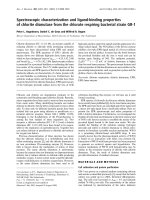
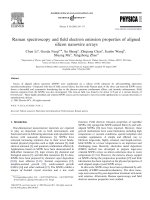
![Structures and electronic properties of si nanowires grown along the [1 1 0] direction role of surface reconstruction](https://media.store123doc.com/images/document/14/rc/td/medium_tdu1394959072.jpg)



